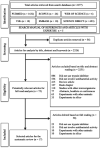Antibacterial action mechanisms and mode of trypsin inhibitors: a systematic review
- PMID: 35168466
- PMCID: PMC8856033
- DOI: 10.1080/14756366.2022.2039918
Antibacterial action mechanisms and mode of trypsin inhibitors: a systematic review
Abstract
This systematic review (SR) aimed to gather studies describing the antibacterial action mechanisms and mode of trypsin inhibitors. The review protocol was registered (PROSPERO: CRD42020189069). Original articles resulting from studies in animal models, in bacterial culture, and using cells that describe antibacterial action of trypsin inhibitor-type peptides or proteins were selected in PubMed, Science Direct, Scopus, Web of Science, BVS, and EMBASE. The methodological quality assessment was performed using the PRISMA and OHAT tool. 2382 articles were retrieved, 17 of which were eligible. Four studies demonstrated the action mechanism directly on the bacterial membrane, and the fifth study on endogenous proteases extracted from the bacteria themselves. The antibacterial action mode was presented in the other studies, which can generate bacteriostatic or bactericidal effects without describing the mechanisms. This study generated information to enable new preclinical or clinical studies with molecules contributing to public health.
Keywords: Antimicrobial peptides; bacteria; bioactive proteins; infectious diseases.
Conflict of interest statement
No potential conflict of interest was reported by the author(s).
Figures


Similar articles
-
Potent antibacterial and antibiofilm activities of TICbf-14, a peptide with increased stability against trypsin.J Microbiol. 2022 Jan;60(1):89-99. doi: 10.1007/s12275-022-1368-9. Epub 2021 Dec 29. J Microbiol. 2022. PMID: 34964945
-
Rational Design and Optimization of Trypsin Inhibitory Peptides with Antibacterial Activity.Curr Comput Aided Drug Des. 2015;11(3):272-8. doi: 10.2174/1573409911666151103113741. Curr Comput Aided Drug Des. 2015. PMID: 26526711
-
Trypsin inhibitory loop is an excellent lead structure to design serine protease inhibitors and antimicrobial peptides.FASEB J. 2007 Aug;21(10):2466-73. doi: 10.1096/fj.06-7966com. Epub 2007 Mar 23. FASEB J. 2007. PMID: 17384140
-
Trypsin inhibitors: promising candidate satietogenic proteins as complementary treatment for obesity and metabolic disorders?J Enzyme Inhib Med Chem. 2019 Dec;34(1):405-419. doi: 10.1080/14756366.2018.1542387. J Enzyme Inhib Med Chem. 2019. PMID: 30734596 Free PMC article. Review.
-
Bacterial target sites for biocide action.Symp Ser Soc Appl Microbiol. 2002;(31):16S-27S. Symp Ser Soc Appl Microbiol. 2002. PMID: 12481825 Review.
Cited by
-
Infiltration-RNAseq Reveals Enhanced Defense Responses in Nicothiana benthamiana Leaves Overexpressing the Banana Gene MaWRKY45.Plants (Basel). 2025 Feb 6;14(3):483. doi: 10.3390/plants14030483. Plants (Basel). 2025. PMID: 39943045 Free PMC article.
-
Di-Arginine Additives for Dissociation of Gold Nanoparticle Aggregates: A Matrix-Insensitive Approach with Applications in Protease Detection.ACS Appl Mater Interfaces. 2022 Nov 23;14(46):52553-52565. doi: 10.1021/acsami.2c17531. Epub 2022 Nov 8. ACS Appl Mater Interfaces. 2022. PMID: 36346346 Free PMC article.
-
Prospecting in silico antibacterial activity of a peptide from trypsin inhibitor isolated from tamarind seed.J Enzyme Inhib Med Chem. 2023 Dec;38(1):67-83. doi: 10.1080/14756366.2022.2134997. J Enzyme Inhib Med Chem. 2023. PMID: 36305291 Free PMC article.
-
Proteomic Characterization of a Lunasin-Enriched Soybean Extract Potentially Useful in the Treatment of Helicobacter pylori Infection.Nutrients. 2024 Jun 27;16(13):2056. doi: 10.3390/nu16132056. Nutrients. 2024. PMID: 38999803 Free PMC article.
-
Analysis of Protein Inhibitors of Trypsin in Quinoa, Amaranth and Lupine Seeds. Selection and Deep Structure-Function Characterization of the Amaranthus caudatus Species.Int J Mol Sci. 2025 Jan 28;26(3):1150. doi: 10.3390/ijms26031150. Int J Mol Sci. 2025. PMID: 39940919 Free PMC article.
References
-
- Nguyen NH, Nguyen CT.. Pharmacological effects of ginseng on infectious diseases. Inflammopharmacol 2019;27:871–83. - PubMed
-
- Assana E, Lightowlers MW, Zoli AP, et al. . Taenia solium taeniosis/cysticercosis in Africa: risk factors, epidemiology and prospects for control using vaccination. Vet Parasitol 2013;195:14–23. - PubMed
-
- Robertson FC, Lepard JR, Mekary RA, et al. . Epidemiology of central nervous system infectious diseases: a meta-analysis and systematic review with implications for neurosurgeons worldwide. J Neurosurg 2019;130:1107–26. - PubMed
Publication types
MeSH terms
Substances
LinkOut - more resources
Full Text Sources
Medical
Molecular Biology Databases
Research Materials
